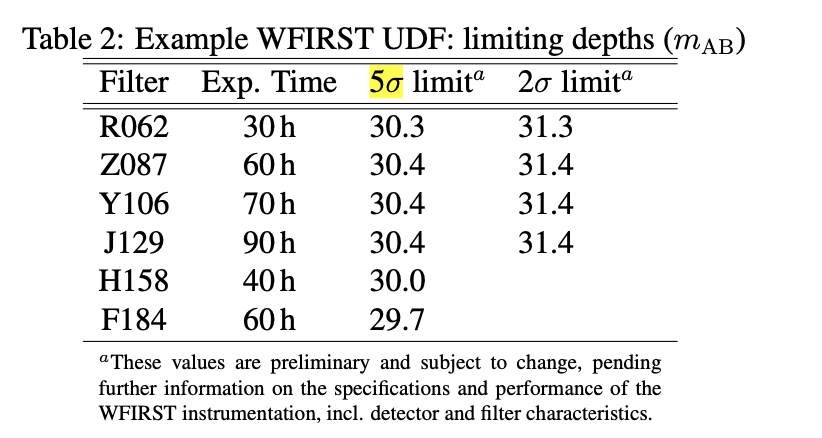Nicole Drakos
Research Blog
Welcome to my Research Blog.
This is mostly meant to document what I am working on for myself, and to communicate with my colleagues. It is likely filled with errors!
This project is maintained by ndrakos
Galaxy Detection
Once I have SEDs for each galaxy, I want to determine whether they will be detected.
Method from Williams et al. 2018
In W18, they say an object is “detected” if it is brighter than the 5\(\sigma\) limits in two photometric bands corresponding to the rest frame UV.
To choose the photometric bands, they take (1) the band that is closest to 1500A, and then (2) the nearest band at a longer wavelength.
For the JADES survey, this corresponds to filters
- F115W, F150W for reshifts 6-7
- F150W, F200W for reshifts 7-9.6
- F200W, F277W for reshifts 9.6-13
Roman Filters
There should be 5\(\sigma\) detection around magnitude of \(m_{\rm AB} \approx 30\), as shown in this table from Koekemoer et al:

Note the different exposure times; in this post I calculated the relative filter depths at the same exposure time.
For each of these filters, we can determine the redshift at which the observed wavelength corresponds to 1500A (using \(z=(\lambda_{obs}-\lambda_{rest})/\lambda_{rest}\))
| Filter | Center | Redshift |
|---|---|---|
| R062 | 6200 | 3.13 |
| Z087 | 8690 | 4.80 |
| Y106 | 10600 | 6.07 |
| J129 | 12930 | 7.62 |
| H158 | 15770 | 9.51 |
| F184 | 18420 | 11.28 |
Therefore, I will use the two filters that bracket each object; e.g. for an object at redshift 8, I will use filters J129 and H158.
If the apparent magnitude in both bands is above \(30\), I will consider it detected.
Calculating in FSPS
FSPS includes many filters, as listed here. It does not currently include the RST filters. For now I will use [sdss_r, wfcam_z, wfcam_y, wfcam_k, wfcam_h, wfc3_ir_f160w, jwst_f200w], because they are roughly similar, but I will add in the proper filters soon.
In FSPS you can use get_mags to get magnitudes in different filters. Since the sps object has been normalized such that the total stellar mass created in the history of the star formation is \(1\) solar mass, the flux has to be multiplied by the \(M/x\), where \(x\) is the stellar mass surviving at the current redshift (from stellar_mass); i.e., you can calculate the magnitude as
m = sps.get_mags(tage=mytage,bands=filter_list) - 2.5*log10(M/sps.stellar_mass)